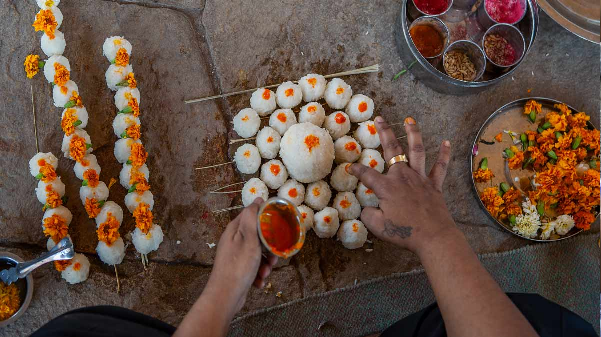Pinda Daan
Pinda Daan is a significant ritual in Hinduism, particularly during ceremonies like the Shraaddha or Pitru Paksha, where the focus is on honoring and appeasing one’s ancestors. The term “Pinda” refers to a rice ball, and “Daan” means offering or donation. Pinda Daan involves the preparation and offering of rice balls to the deceased ancestors as a way to provide spiritual nourishment and seek their blessings. Here’s a detailed explanation of Pinda Daan, including its ritual, performance, and significance:
Ritual and Preparation:
- Selecting an Auspicious Date: Pinda Daan is typically performed on specific occasions, such as the death anniversary (tithi) of the departed individual, during the Shraaddha ceremony, or during the Pitru Paksha fortnight. An auspicious date is chosen based on the Hindu lunar calendar.
- Purification: Before the ritual, the person performing Pinda Daan purifies themselves by taking a bath and wearing clean, traditional clothing. This step is essential to ensure spiritual purity.
- Setting Up the Ritual Area: A clean and sanctified space is prepared, often near a holy river, at home, or at a temple. An altar or platform is decorated with flowers and leaves.
- Preparation of Pindas: Pindas are prepared by mixing rice with sesame seeds and sometimes black gram. The rice balls are shaped into small, round offerings, each representing a deceased ancestor. The number of Pindas made depends on the number of ancestors to be honored.
Performance of Pinda Daan:
- Invocation of Ancestors: The ritual begins with the chanting of specific mantras and prayers, inviting the presence of the ancestors to receive the offerings.
- Offering Pindas: The person performing Pinda Daan places the rice balls on a plate or banana leaves. They offer these Pindas to their ancestors while reciting mantras and prayers. Each Pinda is offered with devotion and reverence.
- Tarpana: After offering the Pindas, water is offered to the ancestors through Tarpana. Black sesame seeds, barley, and water are combined, and the mixture is poured out slowly while facing south. Mantras are chanted during this process.
- Feeding the Brahmins or Priests: Brahmins or priests are invited to partake in the prepared food, which is considered blessed by the ancestors. By sharing the food, it is believed that the ancestors’ blessings are received.
Significance of Pinda Daan:
- Ensuring Ancestral Welfare: Pinda Daan is performed to provide spiritual nourishment to the souls of the deceased ancestors. It is believed that the offerings help the departed souls find peace and progress on their spiritual journey, ensuring their well-being in the afterlife.
- Karmic Balance: Hindus believe in the concept of karma, where actions have consequences. Pinda Daan is considered a way to balance any negative karma associated with one’s ancestors. Fulfilling their spiritual needs can lead to harmony in the family and spiritual progress for both the living and the deceased.
- Expressing Gratitude: Pinda Daan serves as an expression of gratitude, respect, and love towards one’s ancestors. It reinforces the importance of maintaining a connection with one’s heritage and remembering the contributions of those who came before.
In summary, Pinda Daan is a sacred Hindu ritual involving the preparation and offering of rice balls to honor and provide spiritual nourishment to one’s deceased ancestors. It is performed with great reverence and devotion, serving as a means to seek blessings, ensure the welfare of ancestors, and maintain family and spiritual harmony.


